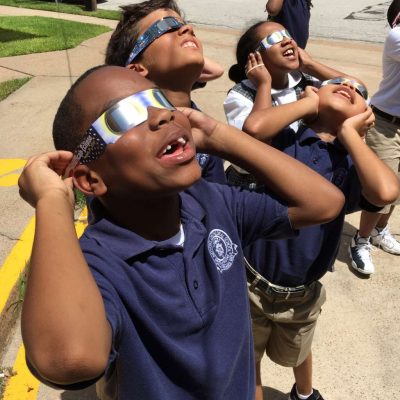
The eclipse is officially over, so what are you going to do with your eclipse glasses? After all, the next time you will see a solar eclipse in North America will be in 2024. You could toss the glasses in the garage, or you could hold on to them and further clutter up your desk drawer. Or… you can donate them. Specifically to Astronomers Without Borders.
Astronomers Without Borders is a group that is collecting glasses to hand out to students in South America and Asia, so they can enjoy the solar eclipse in 2019. By donating your glasses, you’re passing along the experience to a child so they too can enjoy it. Which is kind of a nice thing to do. They don’t have information on where you can send it just yet. But follow their Twitter account for further information: @awb_org or use the hashtag #eclipseglasses

You can also recycle them by removing the lenses. Alternatively you can put them into a memory box or a scrapbook to look back on your time in the years to come. But I like to help people, so I would choose to donate them. It’s a wonderful educational opportunity for a number of communities who might not have access to the glasses they need to safely view the eclipse.
Because it’s all about safety, you should check to see what kind of glasses that you have. There is an actual ISO for eclipse glasses. Apparently they have an ISO for everything. Either way, you’ll want to check that out. Why? Some glasses with the newest certification can be used indefinitely, while others have an expiration date of about three years. According to NASA:

If your eclipse glasses or viewers are compliant with the ISO 12312-2 safety standard, you may look at the uneclipsed or partially eclipsed Sun through them for as long as you wish. Furthermore, if the filters aren’t scratched, punctured, or torn, you may reuse them indefinitely. Some glasses/viewers are printed with warnings stating that you shouldn’t look through them for more than 3 minutes at a time and that you should discard them if they are more than 3 years old. Such warnings are outdated and do not apply to eclipse viewers compliant with the ISO 12312-2 standard adopted in 2015. To make sure you get (or got) your eclipse glasses/viewers from a supplier of ISO-compliant products, see the American Astronomical Society (AAS) Reputable Vendors of Solar Filters & Viewers page.
Which means, maybe you can’t hold onto your glasses until 2024. You’re probably thinking that the next eclipse is less than three years away, so of course you could donate them. But, remember that your glasses might have been manufactured before now. Thus making them unsafe to be used again. NASA gave away 1.5 million pairs of eclipse glasses themselves. They also teamed up with Google and gave away over 2 million pairs to libraries across America. So if you have a pair from NASA directly, then you can probably donate them. What are you going to do with your eclipse glasses? Save, recycle or donate?



